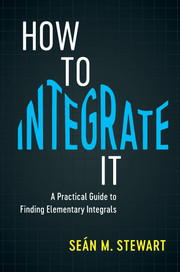Book contents
- Frontmatter
- Contents
- Preface
- 1 The Riemann Integral
- 2 Basic Properties of the Definite Integral: Part I
- 3 Some Basic Standard Forms
- 4 Basic Properties of the Definite Integral: Part II
- 5 Standard Forms
- 6 Integration by Substitution
- 7 Integration by Parts
- 8 Trigonometric Integrals
- 9 Hyperbolic Integrals
- 10 Trigonometric and Hyperbolic Substitutions
- 11 Integrating Rational Functions by Partial Fraction Decomposition
- 12 Six Useful Integrals
- 13 Inverse Hyperbolic Functions and Integrals Leading to Them
- 14 Tangent Half-Angle Substitution
- 15 Further Trigonometric Integrals
- 16 Further Properties for Definite Integrals
- 17 Integrating Inverse Functions
- 18 Reduction Formulae
- 19 Some Other Special Techniques and Substitutions
- 20 Improper Integrals
- 21 Two Important Improper Integrals
- Appendix A Partial Fractions
- Appendix B Answers to Selected Exercises
- Index
5 - Standard Forms
Published online by Cambridge University Press: 11 December 2017
- Frontmatter
- Contents
- Preface
- 1 The Riemann Integral
- 2 Basic Properties of the Definite Integral: Part I
- 3 Some Basic Standard Forms
- 4 Basic Properties of the Definite Integral: Part II
- 5 Standard Forms
- 6 Integration by Substitution
- 7 Integration by Parts
- 8 Trigonometric Integrals
- 9 Hyperbolic Integrals
- 10 Trigonometric and Hyperbolic Substitutions
- 11 Integrating Rational Functions by Partial Fraction Decomposition
- 12 Six Useful Integrals
- 13 Inverse Hyperbolic Functions and Integrals Leading to Them
- 14 Tangent Half-Angle Substitution
- 15 Further Trigonometric Integrals
- 16 Further Properties for Definite Integrals
- 17 Integrating Inverse Functions
- 18 Reduction Formulae
- 19 Some Other Special Techniques and Substitutions
- 20 Improper Integrals
- 21 Two Important Improper Integrals
- Appendix A Partial Fractions
- Appendix B Answers to Selected Exercises
- Index
Summary
As an inverse operation, [integration] requires a great deal of patternrecognition skill and experience.
— Jonathan Borwein and Keith Devlin, The Computer as Crucible: An Introduction to Experimental MathematicsIn this chapter we will begin to extend those ideas first introduced in Chapter 3 for finding primitives of functions that while initially may not be in standard form can be brought into such a form through either manipulation of the integrand or by making use of standard identities for the function under consideration. In all cases we only consider integrals whose primitive can be found in terms of familiar functions such as polynomials, roots, the trigonometric functions and their inverses, and the logarithmic and exponential functions. Function which can be written in this way are said to be elementary. An elementary function is one built up from polynomial and rational functions,1 exponential, logarithmic, and the trigonometric functions and their inverses,2 and obtained by addition, multiplication, division, root extraction, and the operation of repeated composition. Finding an elementary primitive means the integral has been found in elementary terms. For most elementary functions, it is rare to find a primitive in terms of elementary functions. For example, there is no elementary function F such that F’ (x) = ex2 for all x.3
In this chapter we will confine our attention to those cases where elementary primitives for the elementary functions can be found. And while the examples and problems considered here may give the impression an elementary primitive for any elementary function that is continuous and bounded on some closed interval can always be found, it is worth keeping in mind that in general this is very far from being the case.
The general approach to finding an integral in elementary terms largely consists of trying to reduce the integral to a well-known form for which a primitive is known. The list of primitives that we take as being known are those given in Table 3.1 on page 26 of Chapter 3. As primitives for a larger class of functions are slowly found, these will be added to our ever-expanding list of ‘standard’ integrals.
- Type
- Chapter
- Information
- How to Integrate ItA Practical Guide to Finding Elementary Integrals, pp. 53 - 63Publisher: Cambridge University PressPrint publication year: 2017



